PETRIFIED FOREST (Day 6 - part 1)
Our hotel again came with breakfast... although this time we had to use tickets that we had been given at the reception desk when checking in. Odd.
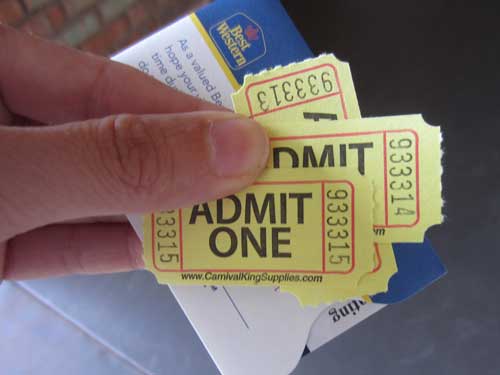

We packed up and headed out. The wind was picking up and it was somewhat chilly out.

Passing by the Painted Desert Indian Center, complete with tipis and large dinosaurs!

A storm threatens in the distance.

The park entrance
The park is basically split into two parts: the Painted Desert (in the northern half) and the Petrified Forest (in the southern). A 27-mile long road runs the length of the park.
As explorers, homesteaders, ranchers, stagecoaches and eventually the railroad arrived in this part of the southwest, it was realized that this region needed to be protected... and fast. An attempt was made in 1895 but failed. Fortunately a monument was created in 1906 by means of the Antiquities Act. While mostly intended to protect prehistoric ruins and artifacts (collectively termed "antiquities") which were rapidly disappearing or being destroyed due to relic hunters, the law could also be used to cover the pieces of petrified wood.
It didn't become a national park until 1962, with its boundaries being extended twice (in 1932 and 1970) to include the Painted Desert.

Click for a large view of the map
Our first stop was at the visitor center.

Clearly we aren't the only ones confused by Arizona time.

Joanne peeks inside a fake petrified log.
We set out to explore the park. Our first stop was Tiponi Point.
Tiponi is the Hopi word for a ceremonial object that symbolizes the religious authority of the person who is holding it. It can be an ear of corn decorated with feathers or a valued stone or figurine and is worn or displayed by a chief or priest.

The road snaked its way along the edge of a mesa top overlooking the desert.

Unfortunately, overcast skies severely dulled the potentially vibrant colors.

The colorful hills were primarily made up of the Chinle Formation, layers of rock deposited 235 - 200 million years ago.
We continued on and arrived at a historic inn.
In 1924, Herbert David Lore registered his Painted Desert Inn under the Homestead Act. He had built it around 1919 using Native American labor and petrified wood and clay. It became known as the Stone Treehouse. Due to its isolation, there was no sewage or power lines, and water had to be hauled 8 miles from the Puerco River. Electricity was generated on site. To attract visitors, Lore cleared a small loop road and offered touring car treks. He also offered Navajo and Hopi artwork.

The inn built of petrified wood
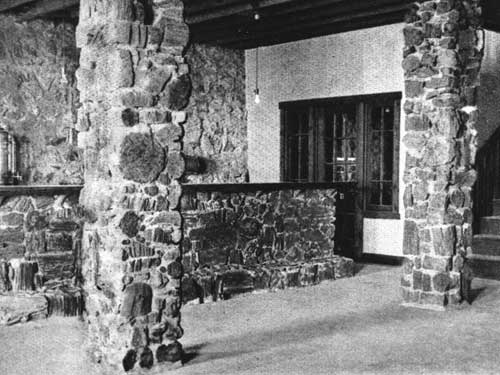
Tha main lobby then...

... and today (used as a Tap Room)
In 1936, Lore sold the building and surrounding land to the National Park Service. The inn had been built on unstable clay, causing the foundation to shift and fracture. Plus it needed to be enlarged.
The Civilian Conservation Core was used to revitalize the building in the Pueblo Revival style (stuccoed masonry, thick walls, earth tones, flat roofs, and vigas or projecting roof beams). Work began in 1937 with new water and sewage, new walls and roof, and also new furnishings. In 1940 it opened for business, with its six guest rooms constantly full.
WWII ended its success and its doors closed in the fall of 1942 when travel became replaced by wartime rationing.

The Civilian Conservation Crew (CCC) here at Camp 3342 in 1938
The CCC was started during the Great Depression in the 1930's. It was a public work relief program designed to put young men to work. It was focused on the conservation and development of natural resources on government owned lands. The men, typically unmarried 18 - 25 year olds, were sent all over the country. They lived in camps on site and got job training as well as literacy classes.
When they arrived here, there were only dirt roads, no bridges over the washes and a tar paper shack for the park headquarters. From 1934 - 1942, they paved roads, built a museum and a park headquarters, created trails, dug a trench and laid a water pipeline (the longest in any park, almost 12 miles), and reconstructed the inn. They made furniture, punched-tin lighting fixtures and even skylights panels.

Rebuilding the inn

Digging the ditch for the water line

The Painted Desert Inn today...
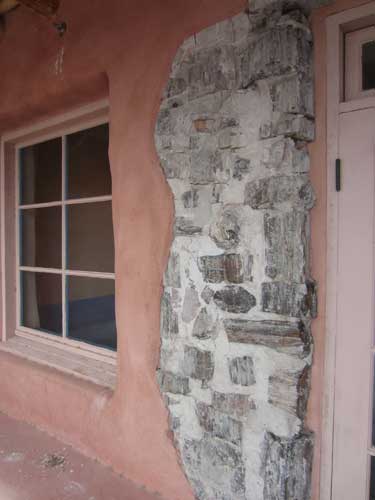
.. with a few reminders of what it used to look like.

The view

A tiny Desert Cottontail rabbit freezes perfectly still, hoping I won't see it.
The Painted Desert Inn was reopened in 1946 and was run by the Fred Harvey Company. Again it was updated with a new color scheme and large murals. Thanks to the CCC, it was no longer so isolated and included several other residences, utility buildings and even a gas station. Unfortunately complications from the foundation remained and by 1958, serious structural defects were being reported. In 1963, the inn was closed.
In 1972, a motion was made to demolish it. Fortunately it was saved and put on the National Register of Historic places. It was renovated and opened as a museum and visitor center in 1975. But, due to roofing, asbestos and heating problems, it was closed again. In 1990 it was back in business... but only for a while. A huge structural overhaul was done from 2004 - 2006 which will hopefully keep it preserved for many years to come.
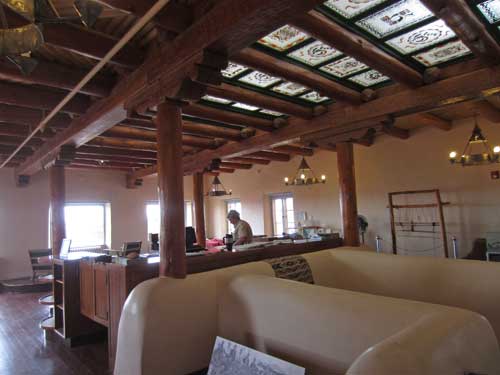
The main Trading Post room was filled with information and exhibits.

The skylight panels were hand-painted by CCC workers based on prehistoric pottery designs.


The dining room contained hand-carved furniture and two large murals.


Fred Kabotie was born on the Hopi Indian Reservation around 1900. In his teens, he was sent to Santa Fe Indian School where he rebelled agains the school's policy of suppressing native cultures. He started painting images from the home he missed and eventually developed an artistic style that gained him attention... including that of Mary Jane Colter, the interior designer responsible for the inn. She hired him to paint the murals at the watchtower at Grand canyon National Park in 1933, and then here in 1948. He died in 1986, having made over 500 paintings.

His 'Three Peaks and Corn Planting' mural features important Hopi symbols, such as corn, rain, eagles and the sacred peaks near Flagstaff.


Some of the animals were obvious (rabbits and lizards) whereas others weren't. Coyote? Fox?

The Salt Lake mural tells the story of two young Hopi men as they walk 230 miles round trip from their home to Zuni Salt Lake on a salt collecting journey.
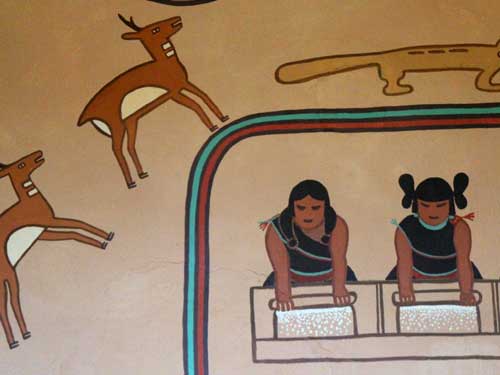
Pronghorn!

Prairie dogs and.... a tadpole?

With salt strapped to their backs, our travelers run from something scary, possibly...

... this mountain lion. This petroglyph was found by Myrl Walker (a park naturalist) in 1934 near Blue Mesa in the park. It was chiseled out of the rock and put on display.

Using historic photos, the 2009 remodel was able to recreate the original atmosphere of the lunch room.


A chocolate sundae...20 cents, a banana split... 30 cents, lemonade... 15 cents, coffee.... 10 cents
Fred Harvey purchased the inn in 1940. As a railroad man, he had to travel a lot. Having grown highly dissatisfied with his meals and accommodations, he decided to revolutionize the hospitality industry. He started in Kansas in 1876. Eventually "Harvey Houses" were popping up all along the Santa Fe Railroad line. The company's head architect and interior designers, Mary Jane Colter, created facilities of grandeur and class. She is responsible for the vibrant colors and also large windows to take advantage of the magnificent views.

Mary Elizabeth Jane Colter (1869 - 1958)
Harvey had noticed a growing problem with rowdy male employees so he decided to exclusively hire women... who became known as the Harvey Girls. They had to be of good moral character, have at least an 8th grade education, be neat, articulate and display good manners. They gave the inn an added level of sophistication while at the same time being able to acheive financial independence for themselves. They weren't not allowed to marry while employed here.

Harvey became known as the "Civilizer of the West."
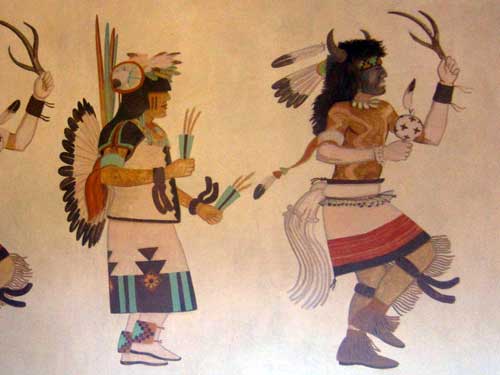
Another of Fred Kabotie's murals graced the wall. The Buffalo Dance is a Hopi ceremony performed in winter to pray for good hunting and snow.

The old kichen
return • continue

